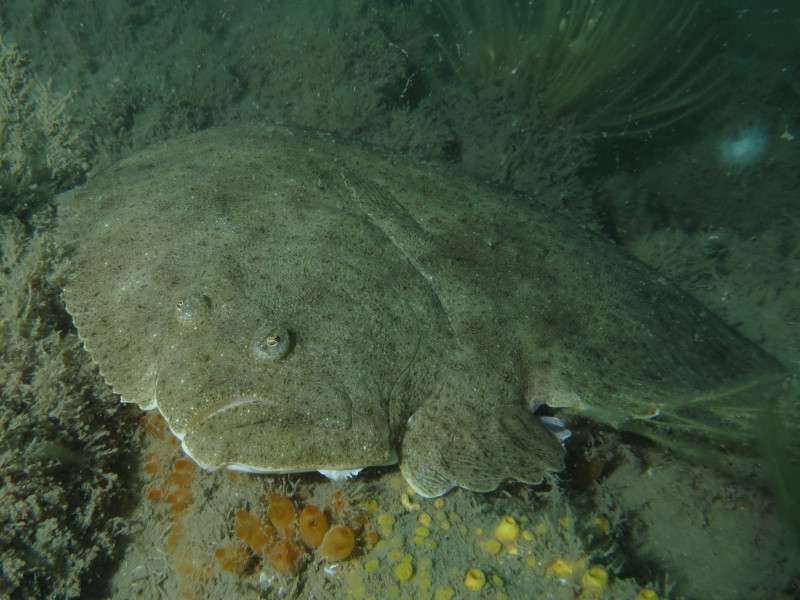Turbot (Scophthalmus maximus)
Distribution data supplied by the Ocean Biodiversity Information System (OBIS). To interrogate UK data visit the NBN Atlas.Map Help
| Researched by | Dr Harvey Tyler-Walters | Refereed by | Admin |
| Authority | (Linnaeus, 1758) | ||
| Other common names | - | Synonyms | Scophthalmus maxima , Scophthalmus maxima , Psetta maxima |
Summary
Description
A large, rounded flatfish with a broad body only one and a half times as long as wide. Usually 50-80 cm in length but can occasionally reach up to 1 m in length. The turbot lays on its right side with left side uppermost. The eyes are on the upper left side. The mouth is large, curved and to the left of the eyes. The dorsal fin starts at the snout in front of the left eye. Neither the dorsal or anal fins continues under the tail. The skin bears no scales but scattered strong bony tubercles on the upper body surface instead. The lateral line is strongly arched over the pectoral fin. Colouration is variable and the fish can change colour to match its background. It is usually a dull sandy-brown to grey, with minute brown, blackish or greenish specks scattered over the body and extending onto the fins. The tail is strongly speckled to its tip. The underside is white occasionally with darker blotches.
Recorded distribution in Britain and Ireland
Found around the coasts of Britain and Ireland but are most common in the south.Global distribution
Found from the Arctic Circle in Norway and Iceland, south along the European coast and the Baltic Sea to the Mediterranean.Habitat
Found on sandy bottoms, gravel or shell gravel from about 20 m to a depth of 80 m but occasionally on muddy bottoms or areas of mixed sand and rock. Young fish may be found inshore in the breaker zone or in shore pools. May also occur in brackish waters.Depth range
-Identifying features
- Body almost circular in outline, about one and a half times as long as wide.
- Dorsal fin with 57-80 rays and anal fin with 43-58 rays.
- The dorsal and anal fins do not continue under the tail.
- The skin lacks scales which are replaced by scattered bony tubercles.
- The tail is densely speckled and the body covered with spots and speckles, although it is well camouflaged.
Additional information
The turbot may be confused with the brill Scophthalmus rhombus which lacks bony tubercles and has a frilly front edge to its dorsal fin. Turbot is a valuable commercial food fish.
Listed by
- none -
Bibliography
Dipper, F., 2001. British sea fishes (2nd edn). Teddington: Underwater World Publications Ltd.
FishBase, 2000. FishBase. A global information system on fishes. [On-line] http://www.fishbase.org, 2001-05-03
Wheeler, A., 1969. The fishes of the British Isles and north-west Europe. London: Macmillan.
Whitehead, P.J.P., Bauchot, M.-L., Hureau, J.-C., Nielson, J. & Tortonese, E. 1986. Fishes of the North-eastern Atlantic and the Mediterranean. Vol. I, II & III. Paris: United Nations Educational, Scientific and Cultural Organisation (UNESCO).
Datasets
Fenwick, 2018. Aphotomarine. Occurrence dataset http://www.aphotomarine.com/index.html Accessed via NBNAtlas.org on 2018-10-01
Isle of Wight Local Records Centre, 2017. IOW Natural History & Archaeological Society Marine Records. Occurrence dataset: https://doi.org/10.15468/7axhcw accessed via GBIF.org on 2018-09-27.
Kent & Medway Biological Records Centre, 2017. Fish: Records for Kent. Occurrence dataset https://doi.org/10.15468/kd1utk accessed via GBIF.org on 2018-09-27.
National Trust, 2017. National Trust Species Records. Occurrence dataset: https://doi.org/10.15468/opc6g1 accessed via GBIF.org on 2018-10-01.
NBN (National Biodiversity Network) Atlas. Available from: https://www.nbnatlas.org.
OBIS (Ocean Biodiversity Information System), 2025. Global map of species distribution using gridded data. Available from: Ocean Biogeographic Information System. www.iobis.org. Accessed: 2025-08-08
Citation
This review can be cited as:
Last Updated: 24/04/2008



